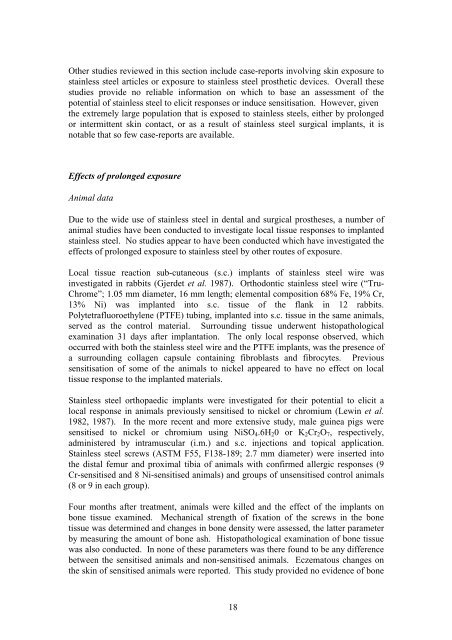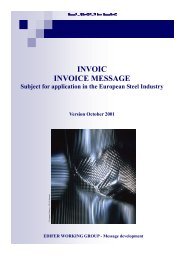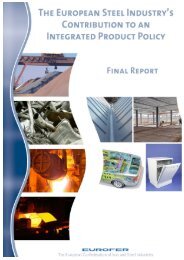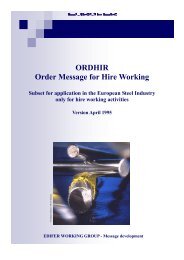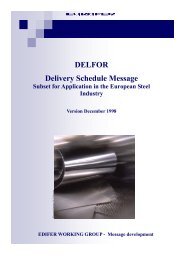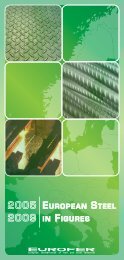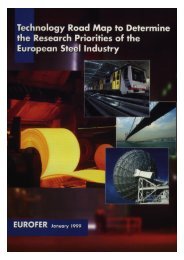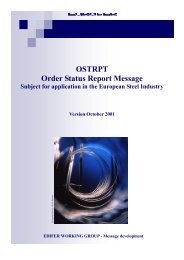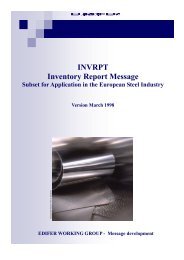manufacture, processing and use of stainless steel - International ...
manufacture, processing and use of stainless steel - International ...
manufacture, processing and use of stainless steel - International ...
You also want an ePaper? Increase the reach of your titles
YUMPU automatically turns print PDFs into web optimized ePapers that Google loves.
Other studies reviewed in this section include case-reports involving skin exposure to<br />
<strong>stainless</strong> <strong>steel</strong> articles or exposure to <strong>stainless</strong> <strong>steel</strong> prosthetic devices. Overall these<br />
studies provide no reliable information on which to base an assessment <strong>of</strong> the<br />
potential <strong>of</strong> <strong>stainless</strong> <strong>steel</strong> to elicit responses or induce sensitisation. However, given<br />
the extremely large population that is exposed to <strong>stainless</strong> <strong>steel</strong>s, either by prolonged<br />
or intermittent skin contact, or as a result <strong>of</strong> <strong>stainless</strong> <strong>steel</strong> surgical implants, it is<br />
notable that so few case-reports are available.<br />
Effects <strong>of</strong> prolonged exposure<br />
Animal data<br />
Due to the wide <strong>use</strong> <strong>of</strong> <strong>stainless</strong> <strong>steel</strong> in dental <strong>and</strong> surgical prostheses, a number <strong>of</strong><br />
animal studies have been conducted to investigate local tissue responses to implanted<br />
<strong>stainless</strong> <strong>steel</strong>. No studies appear to have been conducted which have investigated the<br />
effects <strong>of</strong> prolonged exposure to <strong>stainless</strong> <strong>steel</strong> by other routes <strong>of</strong> exposure.<br />
Local tissue reaction sub-cutaneous (s.c.) implants <strong>of</strong> <strong>stainless</strong> <strong>steel</strong> wire was<br />
investigated in rabbits (Gjerdet et al. 1987). Orthodontic <strong>stainless</strong> <strong>steel</strong> wire (“Tru-<br />
Chrome”; 1.05 mm diameter, 16 mm length; elemental composition 68% Fe, 19% Cr,<br />
13% Ni) was implanted into s.c. tissue <strong>of</strong> the flank in 12 rabbits.<br />
Polytetrafluoroethylene (PTFE) tubing, implanted into s.c. tissue in the same animals,<br />
served as the control material. Surrounding tissue underwent histopathological<br />
examination 31 days after implantation. The only local response observed, which<br />
occurred with both the <strong>stainless</strong> <strong>steel</strong> wire <strong>and</strong> the PTFE implants, was the presence <strong>of</strong><br />
a surrounding collagen capsule containing fibroblasts <strong>and</strong> fibrocytes. Previous<br />
sensitisation <strong>of</strong> some <strong>of</strong> the animals to nickel appeared to have no effect on local<br />
tissue response to the implanted materials.<br />
Stainless <strong>steel</strong> orthopaedic implants were investigated for their potential to elicit a<br />
local response in animals previously sensitised to nickel or chromium (Lewin et al.<br />
1982, 1987). In the more recent <strong>and</strong> more extensive study, male guinea pigs were<br />
sensitised to nickel or chromium using NiSO4.6H20 or K2Cr2O7, respectively,<br />
administered by intramuscular (i.m.) <strong>and</strong> s.c. injections <strong>and</strong> topical application.<br />
Stainless <strong>steel</strong> screws (ASTM F55, F138-189; 2.7 mm diameter) were inserted into<br />
the distal femur <strong>and</strong> proximal tibia <strong>of</strong> animals with confirmed allergic responses (9<br />
Cr-sensitised <strong>and</strong> 8 Ni-sensitised animals) <strong>and</strong> groups <strong>of</strong> unsensitised control animals<br />
(8 or 9 in each group).<br />
Four months after treatment, animals were killed <strong>and</strong> the effect <strong>of</strong> the implants on<br />
bone tissue examined. Mechanical strength <strong>of</strong> fixation <strong>of</strong> the screws in the bone<br />
tissue was determined <strong>and</strong> changes in bone density were assessed, the latter parameter<br />
by measuring the amount <strong>of</strong> bone ash. Histopathological examination <strong>of</strong> bone tissue<br />
was also conducted. In none <strong>of</strong> these parameters was there found to be any difference<br />
between the sensitised animals <strong>and</strong> non-sensitised animals. Eczematous changes on<br />
the skin <strong>of</strong> sensitised animals were reported. This study provided no evidence <strong>of</strong> bone<br />
18


